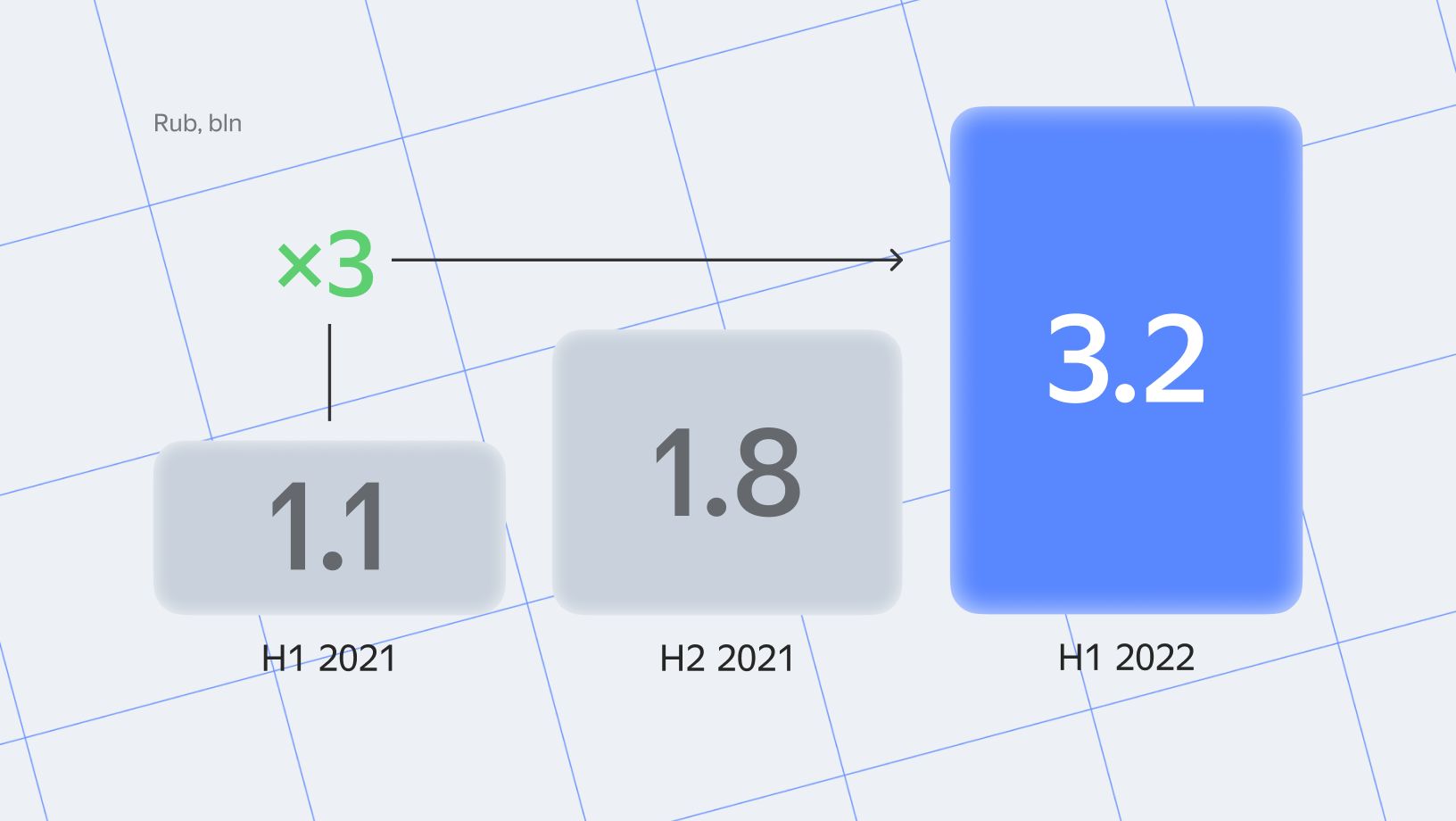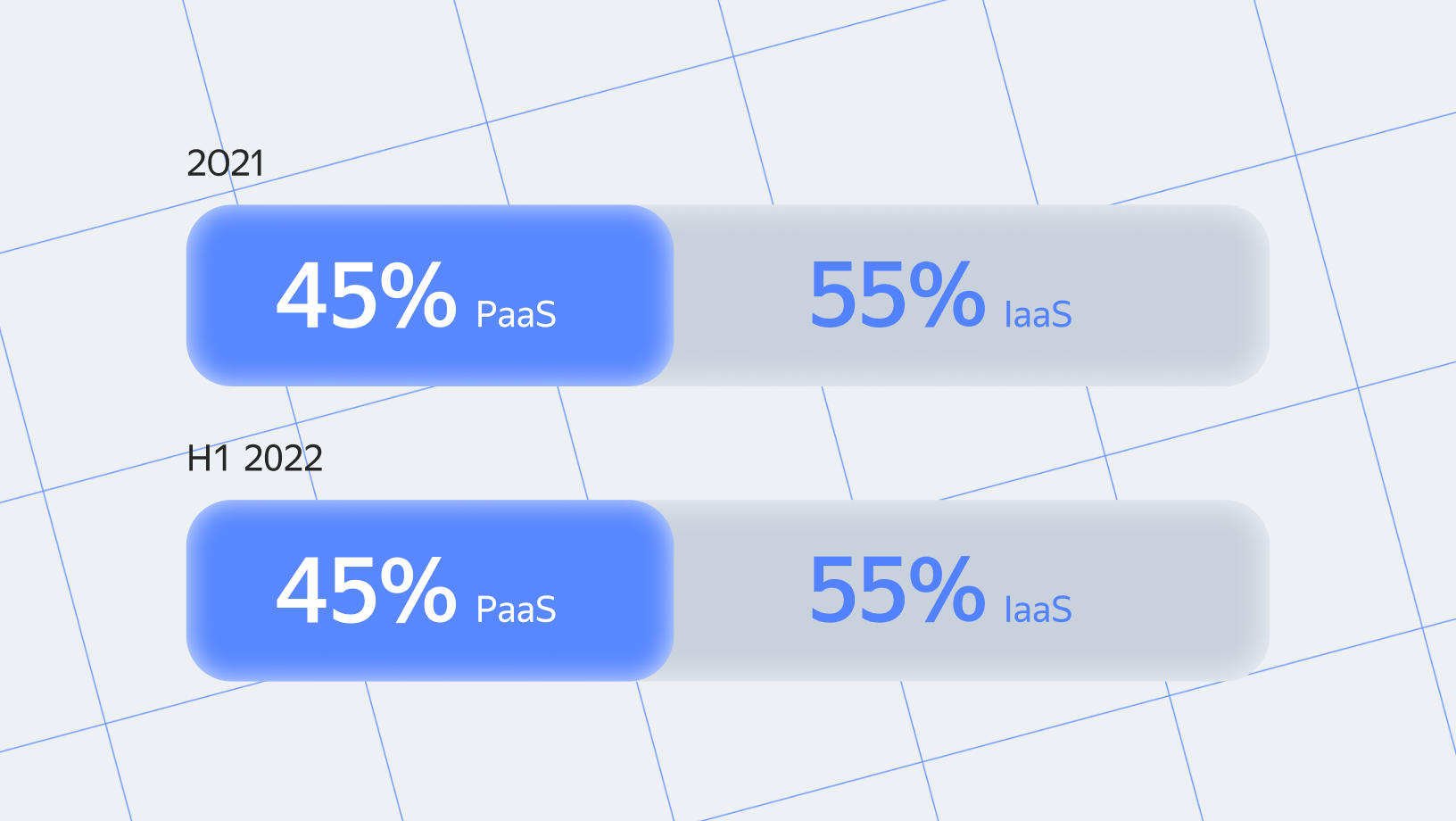23,100 customers use Yandex Cloud services
-
Over 2021, the number of companies working with Yandex Cloud grew more than 1.5 times to 16,000.
-
In the first half of 2022, the number of paying Yandex Cloud customers grew another 1.5 times to 23,100.

This report is not just about sharing our financials — we also want to draw attention to how demand for cloud services has changed across different industries.
Yandex Cloud’s mission of being a reliable platform partner has never been more relevant. On the one hand, the worsening macroeconomic landscape means that companies on the Russian market are facing new challenges every day. On the other, they remain committed to maintaining growth and fulfilling their commitments to their customers. The situation has pushed us to react even faster to change and improve our offering to maximize both the confidence of our customers and partners in our cloud platform, and the value it provides them.

In 2021, Yandex Cloud revenue tripled to 2.9 billion rubles.
Our growth outpaced the overall Russian cloud market for the same period six times over.
In the first half of 2022, Yandex Cloud revenue was 3.2 billion rubles.
That figure is 2.9 times higher than numbers for the first half of 2021, and already eclipses total Yandex Cloud revenue for all of 2021.
Over 2021, the number of companies working with Yandex Cloud grew more than 1.5 times to 16,000.
In the first half of 2022, the number of paying Yandex Cloud customers grew another 1.5 times to 23,100.
The revenue split between large companies and SMEs, however, remained relatively even in both 2021 and the first half of 2022 at 50% each.
Cloud service usage by Yandex companies as a share of total usage was insignificant in both 2021 and the first half of 2022, not exceeding 5%.
72% of users see Yandex Cloud as a long-term platform partner (according to regular internal customer satisfaction surveys in the first half of 2022).
In the first half of 2022, usage of Yandex Cloud services was up by 115% compared to the first half of 2021. Customers are expanding their usage of our services and moving a significant portion of their IT solutions to the cloud, with both internal and external users continuing to start new projects in the cloud after getting a practical feel for the platform.
Both 2021 and the first half of 2022 saw current and new customers expanding their usage of platform services at a pace that accelerated along with the number of overall Yandex Cloud customers. That trend has continued since the beginning of 2021, with the average invoices growing by 104% in comparison with 2020 figures. In the first half of 2022, our average invoice grew by another 64%.
Price increases for some service groups in May 2022 had a minimal impact on the growth of our average invoice in the first half of 2022. Of greater import is the fact that current Yandex Cloud customers and new users alike are using the platform less for experiments in test environments and more to build and run business-critical services.
In this article, we will cover:
“We’re continuing to grow our cloud platform, which offers users access to a complete set of cloud services for streamlining expenses, building new digital projects faster, and transforming the way they do business. As we’ve rounded out our set of services, we’ve also significantly expanded the functionality offered by our existing ones. The next year will see many more updates introduced as we finish work on them”.
In 2021, Yandex Cloud underwent a voluntary certification process for personal data information systems.
At the same time, we confirmed the platform’s compliance with PCI DSS and PCI 3DS, the PCI SSC’s payment data standards designed to ensure security for payment data and financial systems, and GOST R 57580.1-2017.
Since 2021, Yandex Cloud has been compliant with the standard permitting us to process medical data in the cloud.
In 2022, we also became compliant with PCI PIN Security. Companies looking to provide financial services or develop payment gateways or electronic transfer systems can securely manage, process, and transfer PIN codes in the cloud.
We’ve continued to see expansion in the share of revenue and growth contributed by the data platform and automated container management service groups. More and more, companies are using them to build and launch new digital products.
In 2021, the share of revenue contributed by infrastructure services dropped from 60% to 55% in response to growth of the data platform and container development groups.
In the first half of 2022, we saw additional demand for infrastructure services climb as international providers dropped out of the market and users migrated primarily to IaaS. But Yandex Cloud customers continued using more PaaS services, maintaining the existing balance between IaaS and PaaS. In the first half of 2022, the share of revenue contributed by Yandex Cloud’s IaaS services remained at 55%.

Usage for services in the container development group grew by a factor of three in comparison with the same period in 2021. Companies have continued moving to microservice architecture. With that said, usage for our main service group, Managed Service for Kubernetes®, grew over the first half of 2022 by 259%, most often in line with database management services.
The data platform group is still one of the fastest-growing in 2022. In the first half of 2022, usage grew by a factor of 2.5.
Services for working with data are currently being used by 3358 customers. Corporate clients storing and processing data are showing more and more interest for new use cases like dynamic pricing, product analysis, log analysis, all kinds of reporting, and recommendation systems.

Key growth factors for the machine learning group were speech synthesis and recognition. In absolute numbers, Yandex SpeechKit usage grew in the first half of 2022 by almost 60%.
The number of Yandex Tracker accounts in the system at the end of the first half of 2022 had grown 5.7 times since the first half of 2021.
Focusing on user needs and requests, we’ve added more than 100 improvements to the service this year. Among the customers in a variety of industries using the service to automate business processes are TechnoNICOL, a major manufacturer of construction materials, and SkillFactory, an online school focused on working with data.
Over the past year, the number of customers using Yandex DataLens, our data analysis and visualization service, grew 1.6 times.
Yandex DataLens is currently used by companies of varying industries and sizes, from small tech startups to major banks and national retail chains. KazanExpress, a trading platform, implemented a BI system using DataLens to monitor key metrics in real time. That has minimized missed profit and provided a boost for profitable areas, while Yandex DataLens' geoanalytics have helped with accelerated pre-opening analytics for more than 90 parcel lockers in 25 cities across Russia to drive the company’s growth.

One priority for the platform is promoting the serverless computing service group. More than 15% of our major paying customers are already using Yandex Cloud’s serverless tools, unique on the Russian cloud market, to build web apps, create chat bots, work with data, and more. Yandex Cloud is devoting particular attention to the serverless developer community in Russia, sharing expertise between the company and the market. The community already has more than 1000 experts developing serverless products using Yandex Cloud.
“We are continuing to invest in and support the IT community since it is what will keep driving Yandex Cloud’s exponential growth. Developing an ecosystem of service partners who can enhance our platform with their own specialties also helps the IT market grow. In addition, we will go on supporting IT startups and individual developers building digital solutions for the mass market. And our longest-term and largest-scale project is probably widely accessible applied education in the cloud, something we think will create new opportunities for professionals and, needless to say, companies who need their work rather than theoreticians pondering digital transformation.”
Yandex Cloud now has 320 partners. Over the first half of 2022, their number grew by 25%.
Looking to help integrators work more efficiently with customers, we added tech specializations in main product areas to our partner program. The program has also seen the addition of new partner tools protecting investments in Yandex Cloud, including deal registration, online training for partners, cofinancing for customers migrating to the platform, and joint marketing.
We need more of the competencies that cloud platforms demand, so we launched our own educational platform in 2021, also partnering up with third-party educational platforms like Netology, OTUS, and SkillFactory to provide training in cloud technologies. Additionally, we provide support for university students. Our Cloud Service Engineer course, to take one example, is being taught at five top Russian universities.
More than 7700 graduates have been trained in cloud technologies thanks to Yandex Cloud, their number doubling in the first half of 2022 alone.
Yandex Cloud continues to support a grant program for IT startups and scientific projects. Over the past year and a half, we’ve provided almost 300 startups with cloud capacity totaling more than 89 million rubles.
In May 2022, we launched a support program for small tech companies. Its goal is to lower the bar to entry for SMEs making the leap to cloud technologies in a tough time, allowing IT companies to test business hypotheses faster, unlock new niches, and create digital products and services. As part of that program, Yandex Cloud provides resources tech companies can use to build IT projects. A month and a half in, 88 companies have already applied for Yandex Cloud resources.
Our average response speed grew by 116%.
We are answering questions 26% faster.
Over the first half of 2022, customer satisfaction after contacting us grew: negative feedback has dropped from 25% in the second half of 2021 to 7% in the first half of 2022.
“With their experiments complete, many companies are already moving IT systems to the cloud to streamline them and accelerate their time to market. We’re also seeing more cloud natives, small and large companies alike, starting work on new products in the cloud. The last six months have been turbulent for everyone, both for customers individually and industries as a whole. From our vantage point, companies already built for cloud solutions are having a much easier time coping with the changes”.
The companies with the biggest average invoice are still from the IT, banking, and retail sectors:
M.Video-Eldorado Group migrated their customer products to Yandex Cloud. More than 70% of M.Video-Eldorado’s retail operations are currently supported by cloud solutions. Since 2021, the company has tripled its platform service usage.
Rubetek rolled out a combined IoT platform on Yandex Cloud that brings together systems for automated fire alarms, entrance security, access control, resource usage, video surveillance, and smart homes.
But companies in other industries are stepping up their demand for a variety of service groups too.
In the first half of 2022, transportation companies increased their usage of cloud services, their average invoice doubling. The transportation industry leverages cloud services to localize service system data and automate communication with passengers:
HealthTech companies are showing more interest in cloud services (the average invoice grew 2.7 times). An industry favorite is services for cloud data, with the average invoice for the group growing 4.3 times. The platform is used in medicine to securely store and process sensitive data, quickly check hypotheses, and rapidly scale infrastructure:
It’s important to also note the growth in real usage and active interest in what we have to offer on the part of manufacturing. The average invoice for these companies also doubled. Over the past year and a half, manufacturing companies started using machine learning and Managed Service for Kubernetes® much more to automate roll-out, scaling, and management of containerized apps.